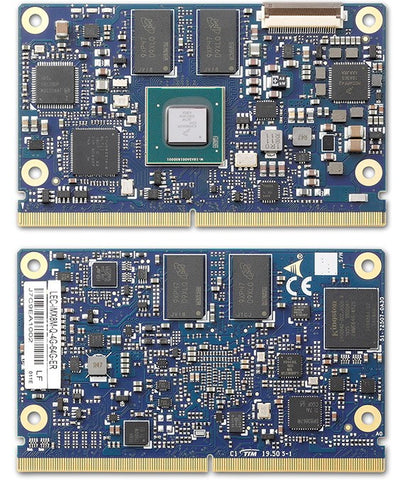I-Pi SMARC AIOMs Speed and Future-Proof AI-Based Designs
A traditional single board computer (SBC) is a complete computer – including a microprocessor unit (MPU), memory, input/output (I/O), and other features required of a functional computer – all realized on a single printed circuit board (PCB). Traditional SBCs also include standard connectors that allow input/output peripherals to be connected directly to the board.
The concept of “future-proofing” an electronic system includes designing the product in such a way as to accommodate the increased computational requirements of evolving and new applications. Unfortunately, the fact that they combine processing functions with other elements means that traditional SBCs can be the limiting factor with regard to future-proofing the systems in which they reside.
One solution for equipment manufacturers who want to “ride the wave” of an increasingly competitive marketplace is to adopt a strategy based on the use of Computer-on-Modules (COMs).
Like an SBC, a COM is a complete embedded computer system implemented on a relatively small PCB. Such a COM is centered around a processor (possibly containing multiple cores), memory, input/output (I/O) controllers, and any other features required to implement a fully functional computer.
Unlike a traditional SBC, however, a COM lacks the standard connectors that would allow input/output peripherals to be connected directly to the board. Instead, the COM is plugged into a carrier board (or “baseboard”), which contains any additional components and subsystems. This allows the COM to focus on providing the core compute capabilities, while the carrier boards provide the “secret sauce” that allows system designers to differentiate their products from competitor offerings.
Using an existing off-the-shelf COM allows system architects to satisfy a wide range of product requirements in a way that reduces development time, effort, and resources, speeds time-to-market, and minimizes risk. Furthermore, using COMs based on industry-standard interface specifications help future-proof the systems in which they reside because it’s possible to replace an existing COM with a higher-performance unit without changing the rest of the system; also, it’s possible to source COMs from multiple vendors as required.
SMARCs: The State-of-the-Art in COMs
The COM concept – having a COM board providing the core compute capabilities residing on a carrier board carrying additional functionality and the design’s “secret sauce” – is of interest in its own right, even if designers are using proprietary (possibly in-house designed) COMs. However, using industry-standard COM offerings allows designers to take full advantage of the benefits offered by a COM-based approach.
There are a number of industry standards for COMs, each addressing different application areas. One of the most popular standards is SMARC (Smart Mobility ARChitecture), whose specification is published by the Standardization Group for Embedded Technologies e.V. (SGET). SMARC COM modules are specifically designed for the development of extremely compact, low-power systems based on ARM and x86 SoCs.

Front (top) and back (bottom) views of a previous generation SMARC module based on the NXP iMX8M
The ability to replace one SMARC COM with another while keeping the same carrier board -- allows scalability, fast time-to-market, and upgradability while maintaining low costs, low power, and small physical size. Furthermore, using industry standard SMARC COMs enables second-source options that are simply not available when using proprietary designs.
The SGET membership includes many of the world’s leading creators of products for embedded computing, test and measurement, and automation applications. In addition to being a key SGET member, ADLINK is one of the driving forces behind the SMARC specification and offers a wide variety of state-of-the-art SMARC COM modules.
AIOMs: The State-of-the-Art in SMARCs
The past few years have seen an explosive growth in the use of artificial intelligence (AI) and machine learning (ML) and the market for AI-enabled products continues to grow exponentially.
Examples of AI-enabled systems include robots, predictive maintenance systems, and intelligent surveillance systems. In the case of robots, the latest generation of industrial robots are known as autonomous mobile robots (AMRs). The fusion of technologies like computer vision, GPS, and AI allows AMRs to perform object detection and recognition and navigate their way around an uncontrolled environment in which the landscape may be constantly changing.
With regard to predictive maintenance applications, systems equipped with AI can monitor things like sounds and vibrations to determine the health of machines. When these AI systems detect anomalies and observe undesirable trends, they can alert their human colleagues as to impending problems, thereby allowing maintenance teams to address these issues without disrupting the operations of the factory or facility.
In the case of surveillance and monitoring applications, smart cameras can be used to detect and recognize people and objects in factories, cities, and homes.
Although AI applications can run on a variety of computing platforms – including microprocessor units (MPUs) and graphics processing units (GPUs) -- tremendous gains in performance accompanied by dramatic reductions in power can be achieved by employing special neural processing units (NPUs). These 21st century processing engines implement all the necessary control and arithmetic logic necessary to execute AI and ML algorithms in the most efficient manner possibly.
The problem with using traditional SMARC modules with standalone NPUs is that designers also need to create the associated carrier boards in such a way that they can accommodate add-on cards carrying the NPU. In addition to increasing the size, cost, and power of the resulting system, this approach negatively impacts development time, effort, and resources, reduces time-to-market, and increases risk.
The solution is to use a SMARC AIOM (AI-on-Module), which is a SMARC COM that carries both MPU and NPU devices.

Based on its history of market leadership, it probably comes as no surprise to discover that ADLINK is one of the driving forces behind the SMARC AIOM specification. In fact, ADLINK defined the AIOM concept in 2018. In March 2020, SGET released the 2.1 version of the specifications, which includes a 4-camera interface and gives AIOM the attention it deserves.
A Desperate Need for SMARC AIOMs
The global AI software market is forecast to experience massive growth in the coming years, with revenues predicted to increase from around $10 billion U.S. dollars in 2018 to $126 billion in 2025.

The AI market includes a wide array of applications, all of which will benefit from access to NPUs in general and SMARC AIOMs in particular. These applications include object detection and recognition, expression analysis, audio event detection and scene classification, surveillance and monitoring, autonomous robots and vehicles, predictive maintenance, and … the list goes on.
Say “Hello” to State-of-the-Art SMARC AIOMs
I-Pi SMARC AIOMs have their CPU and NPU dice -- along with other dice and components -- mounted on a single silicon substrate and presented in the same System-in-Package. Having the CPU and NPU in the same package provides the highest levels of performance combined with the lowest power consumption, thereby making SMARC AIOMs ideal solutions for edge computing applications.

LEC-IMX8M-PLUS development kit
The LEC-IMX8M-PLUS is based on an NXP i.MX 8M Plus (2.3 TOPS, where TOPS refers to “terra operations per second”).
In the same way that the creators of traditional systems enjoy the benefits offered by SMARC COMs - scalability, fast time-to-market, and upgradability while maintaining low costs, low power, and small physical size -- so too will the creators of AI systems enjoy the benefits of SMARC AIOMs
AI is the future of smart embedded systems, SMARC AIOMs are the future of AI, and I-Pi’s AIOMs will allow developers of AI-enabled smart embedded systems to design and deploy cost-effective future-proof products quickly and efficiently. In the next few years, AI will be deployed in a vast array of applications -- all designed to make our lives better -- and I-Pi will continue to be at the forefront of this exciting technology.
